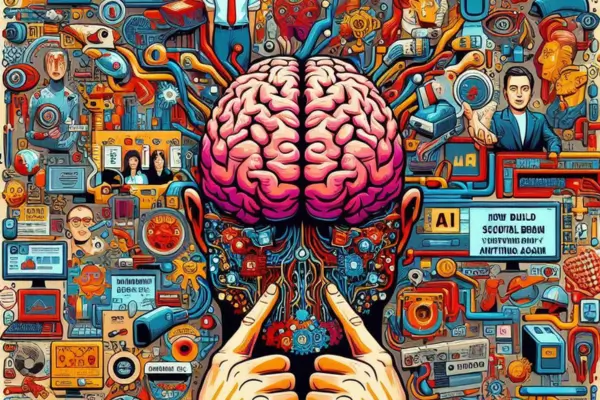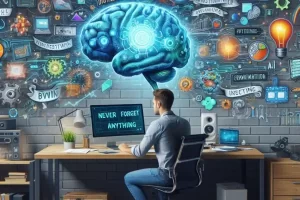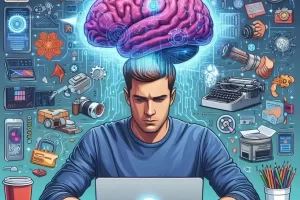We’re living in the information age — but most of us are drowning in content and starving for clarity. We read books, take courses, watch videos, and save articles… but forget 90% of it a week later. That’s why building a personal knowledge library inside your second brain — supported by artificial intelligence (AI) — is a game-changer.
This system doesn’t just store information; it organizes, connects, and evolves your knowledge so you can find, apply, and grow from it for years to come.
In this article, you’ll learn how to create a second-brain-powered knowledge library that becomes your intellectual advantage in everything you do.
Why You Need a Personal Knowledge Library
Most people:
- Highlight books but never revisit them
- Save articles and forget why they mattered
- Learn from podcasts and courses but fail to apply the insights
- Store information in random places — from bookmarks to notebooks to screenshots
The result?
You forget what you already know.
With a second brain and AI:
- You capture your best insights
- You organize them by theme or relevance
- You connect them to real projects or decisions
- You create a living body of knowledge that grows over time
Design Your Library Structure
Start with high-level categories based on your areas of interest or goals. For example:
- 💡 Creativity & Innovation
- 🧠 Psychology & Mindset
- 📈 Business & Strategy
- 📚 Learning & Teaching
- 🛠 Tools & Systems
- 💬 Communication & Writing
- 🔍 Research Topics
- 🎯 Personal Development
Let AI help:
“Suggest a categorization system for a knowledge library focused on entrepreneurship and productivity.”
“Group my existing notes into themes based on content similarity.”
“Create a visual map of my current knowledge areas.”
You now have a foundation for building context, not clutter.
Capture Knowledge in Your Own Words
Don’t just copy-paste. The magic happens when you process information actively.
Each note or entry should include:
- 📌 Source (book, podcast, article, conversation, course)
- ✍️ Summary in your own words
- 🔑 Key takeaways (bullet points)
- 🧩 Tags and related topics
- 🎯 Application idea or quote
- 📅 Date added or reviewed
Ask AI:
“Summarize this 10-page article into 5 bullet points.”
“Translate this complex paragraph into simple language.”
“Suggest where this idea connects to other concepts in my system.”
This turns information into usable knowledge.
Build Evergreen Notes From Repeated Ideas
Some ideas are worth revisiting forever — turn them into evergreen notes.
Evergreen notes:
- Evolve over time
- Link to multiple sources and insights
- Include your interpretation and examples
- Become reference points for thinking and teaching
- Are written as if they’re meant to be shared or reused
Ask AI to help:
“Turn these scattered notes into a single evergreen note on ‘flow state’.”
“What’s missing in this note to make it more complete or timeless?”
“Add examples or applications to make this more practical.”
You now have a growing personal Wikipedia.
Connect Your Notes With Backlinks and Tags
Knowledge compounds when ideas are linked. Use:
- 🧵 Backlinks (bidirectional links between notes)
- 🏷 Smart tagging (topics, goals, energy level, project)
- 🔗 Linked sources and content types
- 🧠 Knowledge graphs (if using Obsidian, Tana, or similar)
Let AI support:
“Suggest 5 notes related to this entry on ‘decision-making.’”
“What ideas or tags frequently show up with ‘creativity’?”
“Cluster my notes into 3-5 knowledge themes I’m exploring most.”
This builds a network of thought, not just a folder of files.
Review and Resurface What You Already Know
Set up a regular review system to keep ideas fresh and top of mind:
- 🔁 Weekly resurfacing (review random old notes)
- 🔎 Search-based review (“What do I already know about this topic?”)
- 📅 Tag ideas for monthly or quarterly review
Use AI to:
“Which notes haven’t been reviewed in 90+ days?”
“Remind me what I’ve learned about ‘focus’ in the last 6 months.”
“Based on this project, what existing insights should I revisit?”
Now your knowledge library keeps itself alive.
Apply Knowledge to Real-Life Decisions and Projects
The power of a personal library is that it feeds your actions and content.
Connect notes to:
- 🛠 Business decisions
- 🎥 Content creation
- 🧪 Experiments or tests
- 🗂 Research projects
- 📅 Daily planning and reviews
Ask AI:
“Pull relevant notes to help me write a blog post about mental models.”
“What past ideas could help with this product launch?”
“What frameworks do I already have that apply to this client problem?”
Now your knowledge pays dividends — instead of gathering dust.
Reflect and Improve the System Over Time
Every few months, ask:
- What categories are growing fastest?
- Which notes do I revisit most often?
- What’s missing in my knowledge landscape?
- How can I improve clarity, structure, or usefulness?
Use AI to:
“Analyze my knowledge library and suggest weak spots.”
“Summarize the top 5 concepts I’ve explored this year.”
“Recommend how to reorganize my categories based on usage.”
This makes your knowledge system adaptive, personal, and scalable.
Real-Life Example: The Learning-Focused Creator
You’re a writer and content creator who reads daily and publishes weekly.
Your second brain includes:
- A categorized library of over 500 notes from books, podcasts, and research
- Evergreen notes that link ideas from across domains
- AI-generated summaries and structured takeaways
- Weekly resurfacing that keeps your best insights top of mind
- A publishing pipeline directly fed by your knowledge vault
You no longer scramble for ideas. Your second brain feeds your creativity and direction.
Final Thoughts: Knowledge Is Only Power When It’s Organized and Applied
You don’t need to consume more. You need a system that helps you:
- Capture what matters
- Clarify what you believe
- Find what you need
- Grow what you know
- Apply what you’ve learned
With your second brain and AI, you don’t just learn more — you become wiser, faster.
Your knowledge library becomes a superpower.
Your insights become a strategy.
Your mind becomes more valuable — every day.




